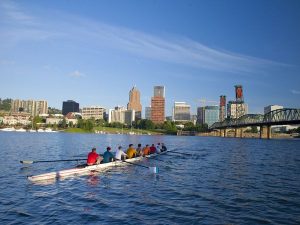Parks and green spaces are necessary to connect us to the outside world. As we zip by life in a fast-paced manner, especially as busy college students, the environment around us can easily be forgotten. By having the parks and green spaces around us, they can serve as a reminder of the importance of the environment and as an escape from our busy lives. In the Cronan Article “The Trouble with Wilderness”, he provides the distinction between the sublime and the wilderness. Wilderness is sacred, untouched nature. “Wilderness is the natural, unfallen antithesis of an unnatural civilization that has lost its soul. It is a place of freedom in which we can recover the true selves we have lost to the corrupting influences of our artificial lives.” The sublime demonstrates a more refined view of nature, creating a romantic, tame version of the wilderness for the public to see and use. He argues that people work their everyday lives in urban cities, thinking that the place where they truly belong is in the wilderness: a distant place where we visit from time to time. By idealizing the wilderness as a distant place, that often means not idealizing the environment in which we actually live, therefore leading to decreased awareness of our actions. Also, by having a sublime, it teaches us to adopt too high a standard of what counts as “natural”.
I agree with Cronan in that people who live in urbanized areas can tend to have a distant mindset of the wilderness and forget to care for the environment around them, but I wouldn’t know a better alternative. By having more people and civilization submerged into the wilderness, the more wilderness becomes tainted, leaving less to be explored and more of the refined sublime or the backyard. Although Cronan argues that people need to be in the wild all the time to remind themselves of the importance of their environment instead of having it as a distant getaway, I believe the the all natural lifestyle is not meant for everyone and that there are other ways for people to be conscious of their environment without having to be submerged in the wilderness all the time. Also, everyone living outdoors would take up more space and be less energy efficient compared to cities, according to Johan Lehrer in “Urban Myths”. Having nature implemented in our lives can be a good reminder for us that the wilderness exists beyond the urban city, and therefore lead to a more environmentally conscious attitude.
One example of creating an environmentally conscious attitude with a place is the Willamette River in Oregon. Along the river, there are park areas and walkways where people can enjoy themselves apart from the city life. People can also kayak, row, or swim in the river. Oregon is known for having an environmentally friendly culture, part of the reason for that could be the increased exposure to nature so close by the city. Portland uses 20% more renewable energy than the national average, one of the first cities to ban plastic bags, and a decent portion of the population uses bike or carpooling methods for transportation. Also having the opportunity to choose the environmentally conscious is important as well. People are surrounded by the sublime version of nature, which could serve as a factor as a reminder to be environmentally friendly.
Understandably, being surrounded in the sublime doesn’t necessarily equate to acting environmentally conscious. For example, there are many residents who live close to the James River. 91.3% of people said it was important to keep waterways, streams, and ditches clean, but only 7.5% said clean watersheds are important. Living near the wilderness is not enough for people to be conscious of their actions. To help, there first needs to be awareness and knowledge about the environment, appraisal of the situation, and changes in behavior. One example of a way that Richmond helps this situation is through the Richmond Folk Festival. Although I did not attend the festival, Eugene’s blog post gave me a peek of what he experienced. The festival did not only bring out “hardcore nature enthusiasts, but rather common people with an appreciation for the river.” Events like this can help with awareness of the environment, and Eugene also mentioned the Cronan article and how national parks and public lands such as Brown Island act as a gateway for further passion in nature.
Cronan also mentions that by idealizing the wilderness as a distant place, that could lead to decreased awareness of our actions towards our immediate surroundings of our everyday lives. As Quinn pointed out in her response on why the long-view in critical to understanding the role humans in natural world, humans tend to look at the short-view of their actions when making decisions. Humans focus on the instant gratification of a solution without taking time to consider the long-term risks involved. Humans do this because it is easy, and it is also easy to forget about the consequences of our actions when we forget about the importance and the beauty of the environment around us. Therefore, by idealizing the wilderness from a distance, making short view decisions is easier to make. To have a reminder in our everyday lives with parks and green spaces can aid us in making long view goals.
I believe that there should be a balance between having a conscious awareness of our current environment and surroundings, and having nature be a part of our everyday lives as a reminder. Parks and green spaces are necessary to connect us to the outside world. Although Cronan may not agree and say that we need to submerge ourselves in the wilderness, not everyone is able to do so. So by having these green spaces, we can remind people to be conscious of their decisions on the environment in the long term through awareness and education of the environment around them.

